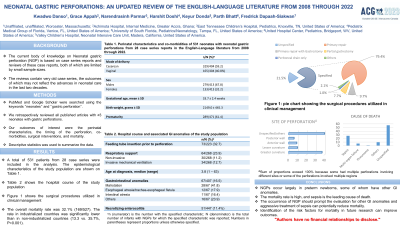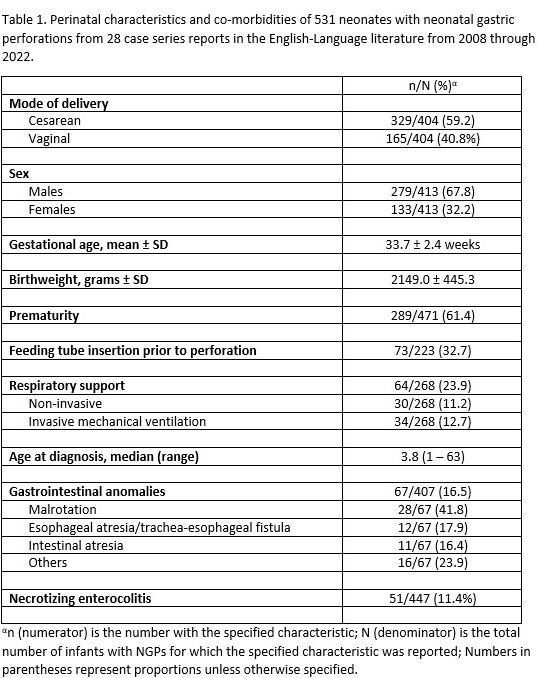Monday Poster Session
Category: Stomach
P2728 - Neonatal Gastric Perforations: An Updated Review of the English-Language Literature from 2008 Through 2022
Monday, October 23, 2023
10:30 AM - 4:15 PM PT
Location: Exhibit Hall

Has Audio

Kwadow Apeadu Danso, MBChB
Worcester, MA
Presenting Author(s)
Kwadow Apeadu. Danso, MBChB1, Grace Appah, MBChB2, Narendrasinh Parmar, MBBS3, Harshit Doshi, MBBS4, Keyur Donda, MBBS5, Parth Bhatt, MD6, Fredrick Dapaah-Siakwan, MD7
1Worcester, MA; 2Achimota Hospital, Accra, Greater Accra, Ghana; 3East Tennessee Children's Hospital, Alcoa, TN; 4Pediatrix Medical Group, Fort Myers, FL; 5University of South Florida, Tampa, FL; 6United Hospital Center, Bridgeport, WV; 7Valley Children's Healthcare, Madera, CA
Introduction: Neonatal gastric perforation (NGP) is rare and the current body of knowledge on NGP is based on case series reports and reviews of these case reports, both of which are limited by small sample sizes. Further, the reviews contain very old case series, the outcomes of which may not reflect the advances in neonatal care in the last 2 decades. The objective of this review was to characterize the epidemiology, hospital course, and outcomes of NGP in a contemporary cohort over the past 15 years from 2008 through 2022.
Methods: We retrospectively reviewed all published articles with ≥3 neonates with gastric perforations. We searched PubMed and Google Scholar using the keywords ‘’neonates’’ and ‘’gastric perforation’’. We extracted data from individual articles onto an Excel spreadsheet for additional analysis. The outcomes of interest were the perinatal characteristics, the timing of the perforation, co-morbidities, surgical interventions, and mortality. Due to the heterogeneous nature and differences in reporting, for each outcome of interest, the analysis was limited to the case series’ that had complete information on that particular outcome of interest. Descriptive statistics were used to summarize the data.
Results: A total of 531 patients from 28 case series were included in the analysis. The majority were male (279/413, 67.8%) and preterm (289/471, 61.4%). The mean gestational age and birthweight were 33.7 ± 2.4 weeks and 2149.0 ± 445.3 g, respectively [Table 1]. Perforations occurred at a median age of 3.8 days. Prior to the perforation, 32.7% (73/223) had feeding tubes inserted and respiratory support occurred in 23.9% (64/268). Congenital gastrointestinal (GI) anomalies were present in 16.5% (67/407), of which malrotation was the commonest (28/67; 41.8%). Where the site of the perforation was specified, the majority occurred on the greater curvature (197/531; 37.1%). Primary repair was the most common (328/413, 79.4%) procedure performed. While the overall mortality was 32.1% (169/527), the mortality rate in industrialized countries was significantly lower than in non-industrialized countries (13.3 vs 35.7%, P=0.001). The leading cause of death was sepsis (46/169; 27.2%).
Discussion: NGPs occur largely in preterm newborns, some of whom have other GI anomalies. The mortality rate is high, and sepsis is the leading cause of death. Thus, the occurrence of NGP should prompt the evaluation for other GI anomalies and increased attention to antisepsis can potentially reduce mortality.

Disclosures:
Kwadow Apeadu. Danso, MBChB1, Grace Appah, MBChB2, Narendrasinh Parmar, MBBS3, Harshit Doshi, MBBS4, Keyur Donda, MBBS5, Parth Bhatt, MD6, Fredrick Dapaah-Siakwan, MD7. P2728 - Neonatal Gastric Perforations: An Updated Review of the English-Language Literature from 2008 Through 2022, ACG 2023 Annual Scientific Meeting Abstracts. Vancouver, BC, Canada: American College of Gastroenterology.
1Worcester, MA; 2Achimota Hospital, Accra, Greater Accra, Ghana; 3East Tennessee Children's Hospital, Alcoa, TN; 4Pediatrix Medical Group, Fort Myers, FL; 5University of South Florida, Tampa, FL; 6United Hospital Center, Bridgeport, WV; 7Valley Children's Healthcare, Madera, CA
Introduction: Neonatal gastric perforation (NGP) is rare and the current body of knowledge on NGP is based on case series reports and reviews of these case reports, both of which are limited by small sample sizes. Further, the reviews contain very old case series, the outcomes of which may not reflect the advances in neonatal care in the last 2 decades. The objective of this review was to characterize the epidemiology, hospital course, and outcomes of NGP in a contemporary cohort over the past 15 years from 2008 through 2022.
Methods: We retrospectively reviewed all published articles with ≥3 neonates with gastric perforations. We searched PubMed and Google Scholar using the keywords ‘’neonates’’ and ‘’gastric perforation’’. We extracted data from individual articles onto an Excel spreadsheet for additional analysis. The outcomes of interest were the perinatal characteristics, the timing of the perforation, co-morbidities, surgical interventions, and mortality. Due to the heterogeneous nature and differences in reporting, for each outcome of interest, the analysis was limited to the case series’ that had complete information on that particular outcome of interest. Descriptive statistics were used to summarize the data.
Results: A total of 531 patients from 28 case series were included in the analysis. The majority were male (279/413, 67.8%) and preterm (289/471, 61.4%). The mean gestational age and birthweight were 33.7 ± 2.4 weeks and 2149.0 ± 445.3 g, respectively [Table 1]. Perforations occurred at a median age of 3.8 days. Prior to the perforation, 32.7% (73/223) had feeding tubes inserted and respiratory support occurred in 23.9% (64/268). Congenital gastrointestinal (GI) anomalies were present in 16.5% (67/407), of which malrotation was the commonest (28/67; 41.8%). Where the site of the perforation was specified, the majority occurred on the greater curvature (197/531; 37.1%). Primary repair was the most common (328/413, 79.4%) procedure performed. While the overall mortality was 32.1% (169/527), the mortality rate in industrialized countries was significantly lower than in non-industrialized countries (13.3 vs 35.7%, P=0.001). The leading cause of death was sepsis (46/169; 27.2%).
Discussion: NGPs occur largely in preterm newborns, some of whom have other GI anomalies. The mortality rate is high, and sepsis is the leading cause of death. Thus, the occurrence of NGP should prompt the evaluation for other GI anomalies and increased attention to antisepsis can potentially reduce mortality.

Figure: Table 1.
Disclosures:
Kwadow Danso indicated no relevant financial relationships.
Grace Appah indicated no relevant financial relationships.
Narendrasinh Parmar indicated no relevant financial relationships.
Harshit Doshi indicated no relevant financial relationships.
Keyur Donda indicated no relevant financial relationships.
Parth Bhatt indicated no relevant financial relationships.
Fredrick Dapaah-Siakwan indicated no relevant financial relationships.
Kwadow Apeadu. Danso, MBChB1, Grace Appah, MBChB2, Narendrasinh Parmar, MBBS3, Harshit Doshi, MBBS4, Keyur Donda, MBBS5, Parth Bhatt, MD6, Fredrick Dapaah-Siakwan, MD7. P2728 - Neonatal Gastric Perforations: An Updated Review of the English-Language Literature from 2008 Through 2022, ACG 2023 Annual Scientific Meeting Abstracts. Vancouver, BC, Canada: American College of Gastroenterology.
